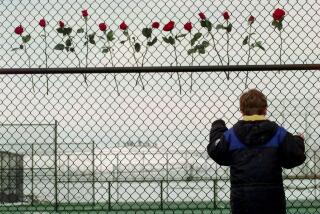2012 is tragic, but mass shootings not increasing, experts say
As Howard B. Unruh barricaded himself in his home against the police -- after finally running out of ammunition -- he got a call from an assistant city editor at a local newspaper who had looked up his phone number.
“Why are you killing people?” asked the editor, Philip W. Buxton.
“I don’t know,” Unruh replied. “I can’t answer that yet. I’ll have to talk to you later. I’m too busy now.”
It was 1949 in Camden, N.J., and Unruh had just killed 12 people and injured four others with a Luger pistol, including women and children.
Although some indications suggest the American public has reached a breaking point after the Sandy Hook Elementary School shooting -- yet another tragic mass shooting in a particularly tragic year -- such attacks have long been a part of American history, and some experts say they are happening not much more often than usual.
“There is one not-so-tiny flaw in all of these theories for the increase in mass shootings,” James Alan Fox, a criminologist at Northeastern University in Boston, wrote for Boston.com in August. “And that is that mass shootings have not increased in number or in overall body count, at least not over the past several decades.”
Fox cited a particularly broad set of FBI and police data that counted shootings between 1980 and 2010 in which four or more people were killed: The average pace was about 20 mass murders per year, with a death toll of about 100. Casualty counts fluctuated wildly -- some years would have almost 125 dead, but then be followed by a year with fewer than 50 mass shooting fatalities. Far steadier was the number of attacks, which usually stayed at fewer than 25 per year.
This year has been especially bloody, though. According to a running tally by Mother Jones magazine, whose counts slightly differ -- the magazine excluded robberies and gang violence, to some criticism, and limited the tally to public attacks -- 2012 has been the deadliest year for mass shootings since 1982 by far, with almost 80 dead.
The overall number of casualties, when injuries are included, made 2012 almost twice as bloody as the next-worst years: 1999 and 2007, when massacres at Columbine High School in Littleton, Colo., and Virginia Tech University in Blacksburg, Va., respectively, inflated the numbers.
Mass shootings make up only a small fraction of the country’s overall gun crime. Between 2007 and 2011 -- which saw an almost unprecedented drop in violent crime -- the U.S. experienced an average of 13,700 homicides, with guns responsible for 67% of the killing, according to the FBI’s crime reports.
But experts say it’s the spectacular nature of the attacks that give public mass shootings such impact beyond the affected communities, with intense media coverage lending extra piquance: five or six or even seven attacks in one year may not be statistically significant, but they’re emotionally resonant.
“What we’ve seen after Aurora and what we’ve seen after Newtown is kind of the typical response that we’ve seen over the last 50 years following high-profile mass public shootings,” said Grant Duwe, a criminologist for the Minnesota Department of Corrections who’s written a book on the history of mass murders since 1900.
Duwe has counted 21 mass shootings between 1900 and 1966, which was the year Charles Whitman took to the University of Texas tower in Austin, part of a rampage that killed 15 people, including a pregnant woman. Two weeks before, Richard Speck had killed eight student nurses at the University of Chicago.
Both of these cases tripped off an emotional maelstrom that marked a new era of public killings in the United States; the two attacks became central points of reference in public debate and started a period when guns became more prominent weapons for such killings.
“We had mass public shootings before 1966, but the frequency with which those cases occurred is less than what we’ve observed since the mid-1960s,” Duwe said.
The country saw an increase in mass public killings during the 1980s and ‘90s, but Duwe’s tallies showed that mass shootings had decreased since then. The 26 public shooting massacres he tallied between 2000 and 2009 were significantly down from the 43 cases he counted in the 1990s. (Duwe counts shootings in public places that result in four or more dead, but he excludes robberies and gang violence.)
But Duwe acknowledged that there seemed to be more emotional resonance behind the Newtown, Conn., school attack compared with even the recent massacres in Tuscon, Ariz., and Aurora, Colo.
“What makes the Newtown mass shooting different qualitatively is that we do have a significant loss of young, innocent, precious lives,” he said. “That may pack enough emotional power to bring about reinstatement of, say, the assault weapons ban.”
Whether any policy change lasts is a different question. Duwe pointed out that the 1994 assault-weapons ban passed after a wave of high-profile shootings in the ‘80s and early ‘90s -- but then time passed, and the law lapsed, and the debate has begun all over again.
ALSO:
‘Puppies for Rent’ business in Utah sparks criticism
L.A. girls pay tribute in visit, but Newtown is a day of hearses
‘No, no, no’: Harrowing 911 call, then 4 dead near Longmont, Colo.
More to Read
Start your day right
Sign up for Essential California for news, features and recommendations from the L.A. Times and beyond in your inbox six days a week.
You may occasionally receive promotional content from the Los Angeles Times.






